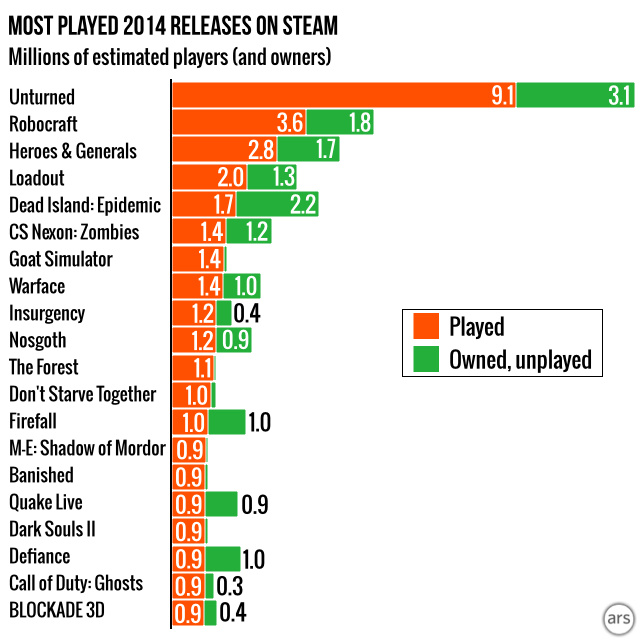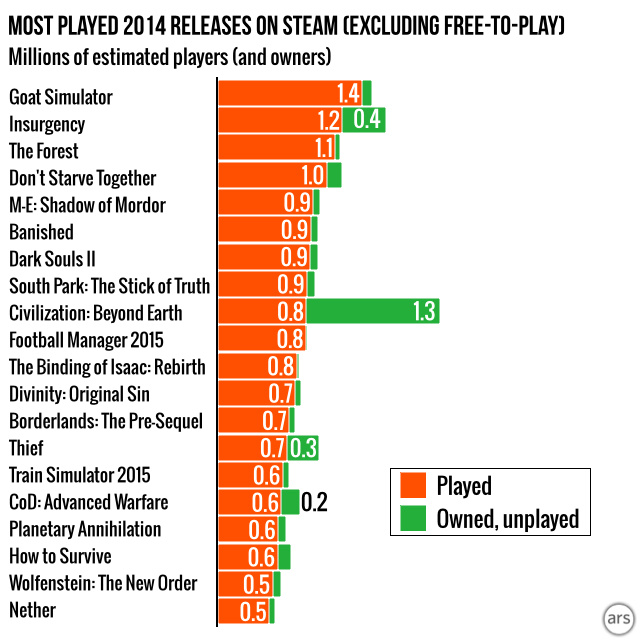
(Update March 5: A few graphs have seen minor adjustments—2013 release Call of Duty: Ghosts was removed from the "most played" graph, and free-to-play title Dead Island: Epidemic was removed from the pay-to-own graph. The "Top 400" list has also been corrected to fix occasional row mismatches between games and developers/publishers. We regret the errors)
When we first unveiled the Steam Gauge project last April, we were tracking just over 2,700 games released on Steam to that point. Since then, the library of games on Steam has ballooned to include more than 4,400 games by our count. That's incredible acceleration for a service that until recently was satisfied to grow slowly. For context, the last 18 months have seen as many new games added to Steam as the service's first 10 years combined.
All of that is to say, we're long overdue to see what Steam users have been buying and playing from that new crop of games. And that means diving back into our random sampling of public Steam data to estimate sales for all the Steam games released in 2014. We'll be slicing that data a number of ways in this piece and even providing a good deal of raw data for you to slice it up yourselves at the end if you wish.If you haven't already, please look back at our original Steam Gauge piece for a detailed explanation of how we came up with the numbers referenced here. Keep in mind, while we feel these estimates are relatively reliable, they are still estimates. These figures may not precisely match the reality reported to and by individual developers. When we've been able to compare our estimates to actual reports, we find they overwhelmingly fall within 10 percent of each other in either direction. Also remember that PC games that aren't sold or registered on Steam don't appear in this data.
Numbers reported here were measured on February 26, 2015 unless otherwise noted.
A couple of missing games
One major caveat before we dive right into the data—there's been a slight change to the methodology we used when we first debuted Steam Gauge. Back then, we were getting data by scraping public pages on SteamCommunity.com. Since then, Valve has been in touch to discuss how we were using those public data resources. After some back and forth, we are now getting similar data using Steam's public API, which puts less strain on Valve's Web interface.
On the plus side, this change has actually improved the efficiency of our data collection. Where we previously got data from up to 80 to 90,000 valid players per day, we're now studying 170-to-210,000 Steam players a day. That's over half a million in an average three-day sample. We've also revamped our code to make the collection process less susceptible to crashes and gaps when running on our Amazon EC2 instance.
On the downside, using the Steam API seems to have removed data from two of the biggest games on the service. For some reason, Dota 2 and Team Fortress 2 don't seem to appear in our new, API-driven model, even though many other free-to-play titles seem to be measured just fine. This is a pretty major omission, considering that these games combined for over 46 million estimated players last April (and doubtlessly more today). We're not sure if this problem is on our end or Valve's. Regardless, their removal likely affects some of the 2014 sales and gameplay performance measured later in the piece.
Unturned rules the year

The top-selling game of 2014 is one I'll admit I've heard surprisingly little about. The elevator description for Unturned sounds like a crass combination of everything that's currently trendy in PC game design: Minecraft-style blocky graphics and crafting, zombie-infested survival gameplay, a focus on co-operative play, and a free-to-play, "Early Access" business model. It's a combination that works well apparently, leading to downloads from over 12 million Steam users by our estimates. It's hard to know how many of those players are actually spending money on the game, of course, but with that many copies out there, the revenue numbers likely aren't small.

Looking past the top slot, free-to-play games continue to dominate the top "sellers" on Steam. Only two of the top ten most downloaded games ask players to pay up front, and only six of the top 20. Some people may not feel that's a fair comparison, since free-to-play games could easily be "impulse downloads" that users decide to get and then promptly forget about.
The gameplay hours statistics give some credence to that argument: a surprising number of the top free-to-play games look less impressive when you take out people who haven't registered any playing time yet. That includes a full 25 percent of users that downloaded top-performer Unturned and about one-third of the "owners" for free-to-play runner-up Robocraft.
It might seem odd that so many people would go to the trouble of clicking through to download these free-to-play titles without playing them at least once. It's not so hard to believe when you think about it, though. When browsing the Steam store, many users probably start downloading these free titles on the assumption they may want to play sometime later (and why not... it's free!).
Once the download is done, though, a user may have already returned to the familiar, tried-and-true games they already know and love. Sometimes it's much easier to return to a game that's a known quantity than to invest time in a largely unknown free-to-play title, even if it has already been downloaded.

In any case, <sarcasm>for you dead-enders that insist on paying money for a complete game experience before you play it </sarcasm>, we've generated a breakdown of those top pay-to-play performers. Here, finally, are many of the year's heavily hyped AAA titles from major publishers as well as a few indie darlings that have found a surprisingly large niche (Goat Simulator, we're looking at you).
For the most part, the top pay-to-play games see a much higher ratio of players to owners: people who paid money for a game released in 2014 overwhelmingly put at least a little bit of time into their purchases. Comparing the pay-to-play numbers to the free-to-play brethren, though, shows how much harder it is for the more traditional releases to amass large numbers of players. It's striking. Only five paid 2014 releases on Steam registered at least a million players, compared to eight free-to-play games with that many players for instance.

There's one more important data point to take into account when determining 2014's most popular Steam games: number of days on the market. Games released early in the year had more time to amass a following, after all, while more recent releases might still be basking in the heightened sales period that accompanies a game's release (Note: Games released in "Early Access" before their officially listed release date may in effect get a pre-release sales boost that skews these ratios). Dividing out downloads by number of days since release shows a few games with pretty consistent staying power so far (Unturned, Robocraft, Heroes & Generals) and others whose fates after their current honeymoon launch period are less clear (Dead Island: Epidemic, Don't Starve Together, Dizzel).
reader comments
127